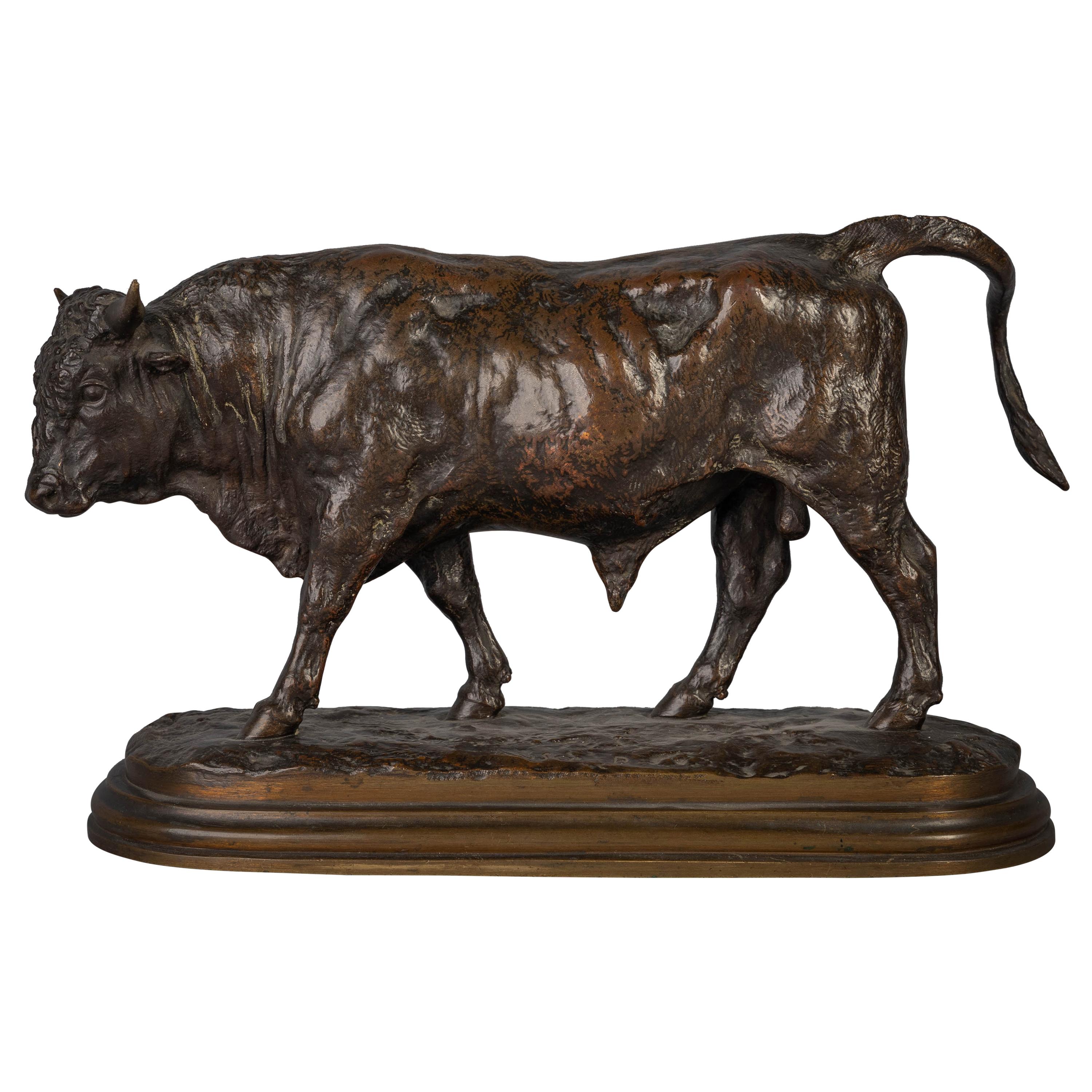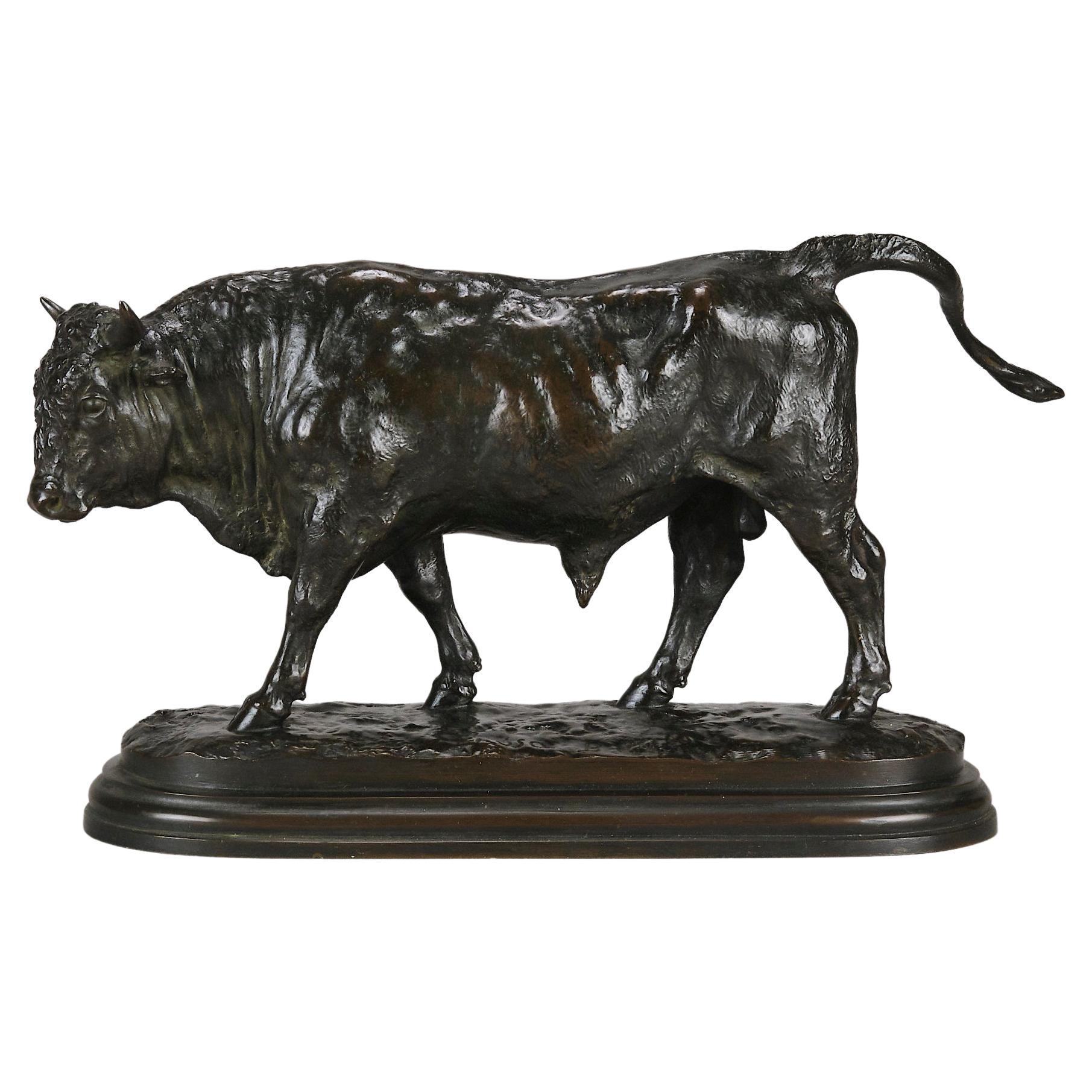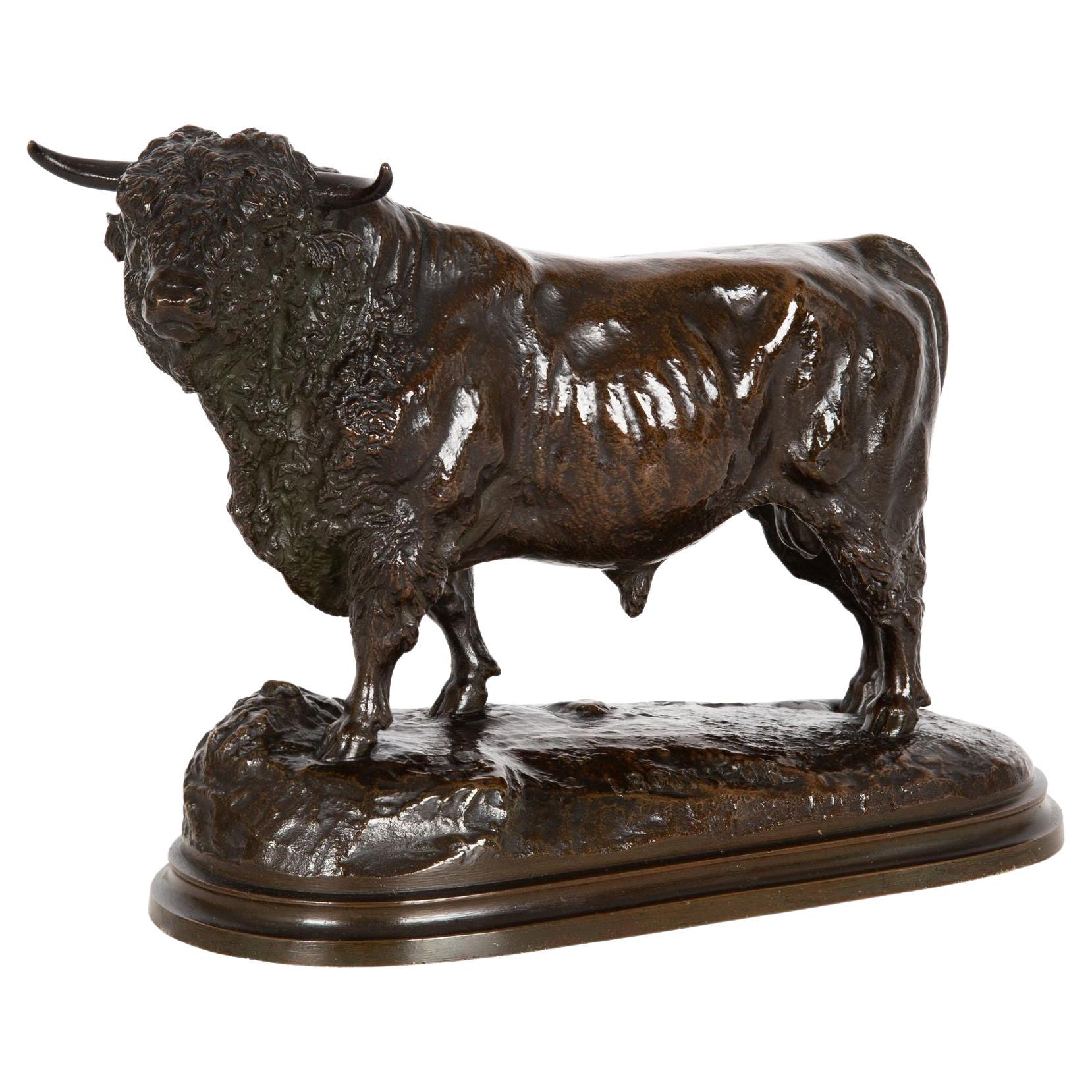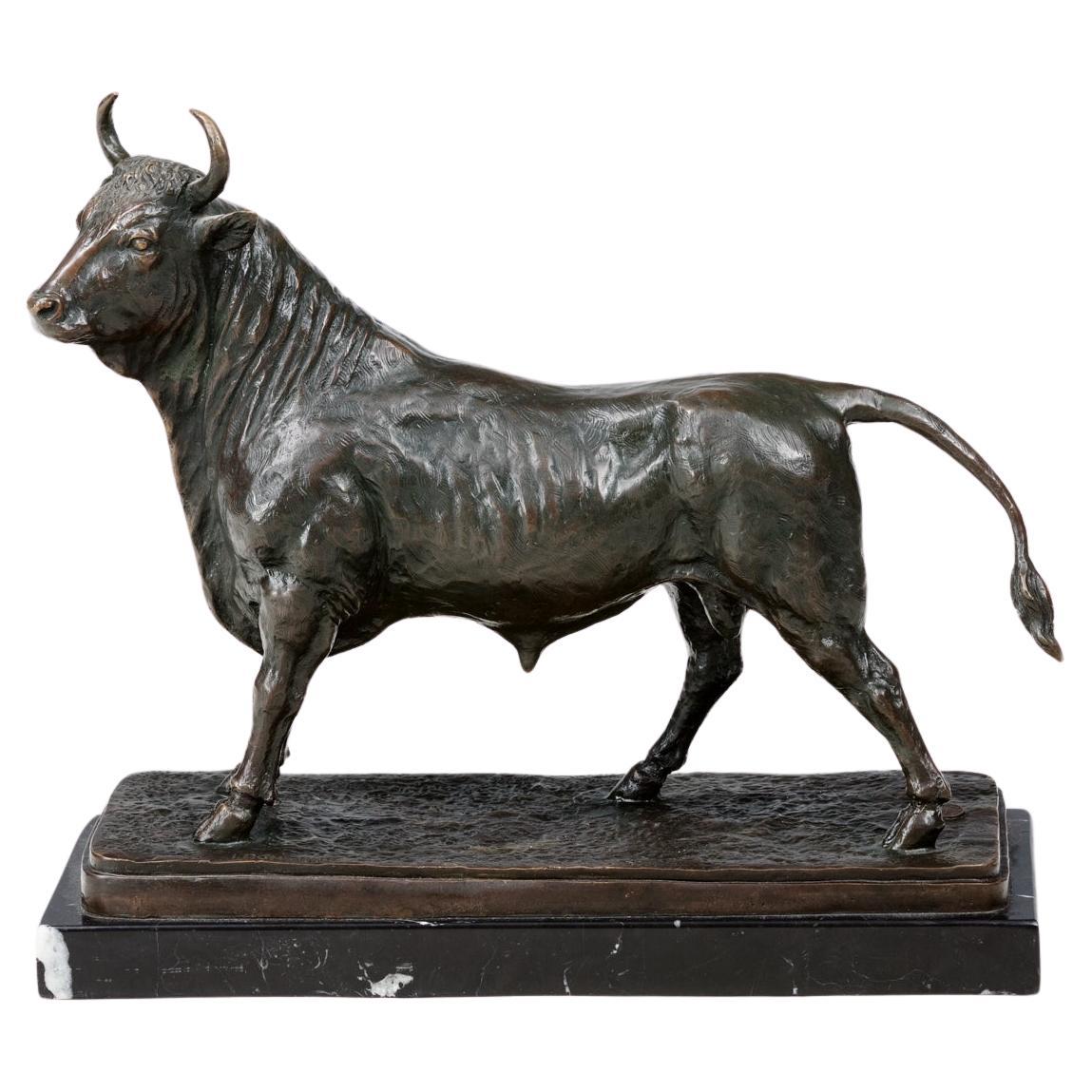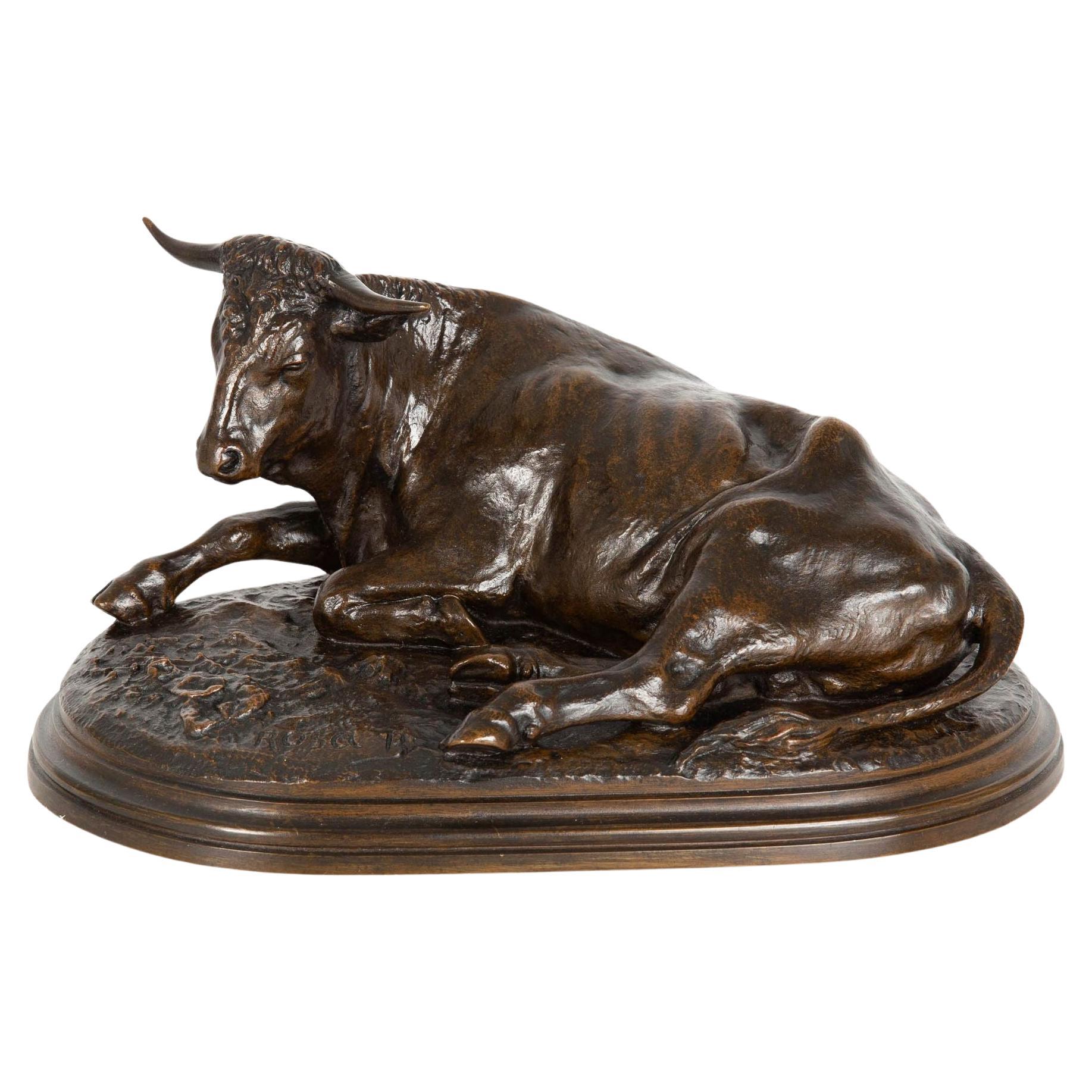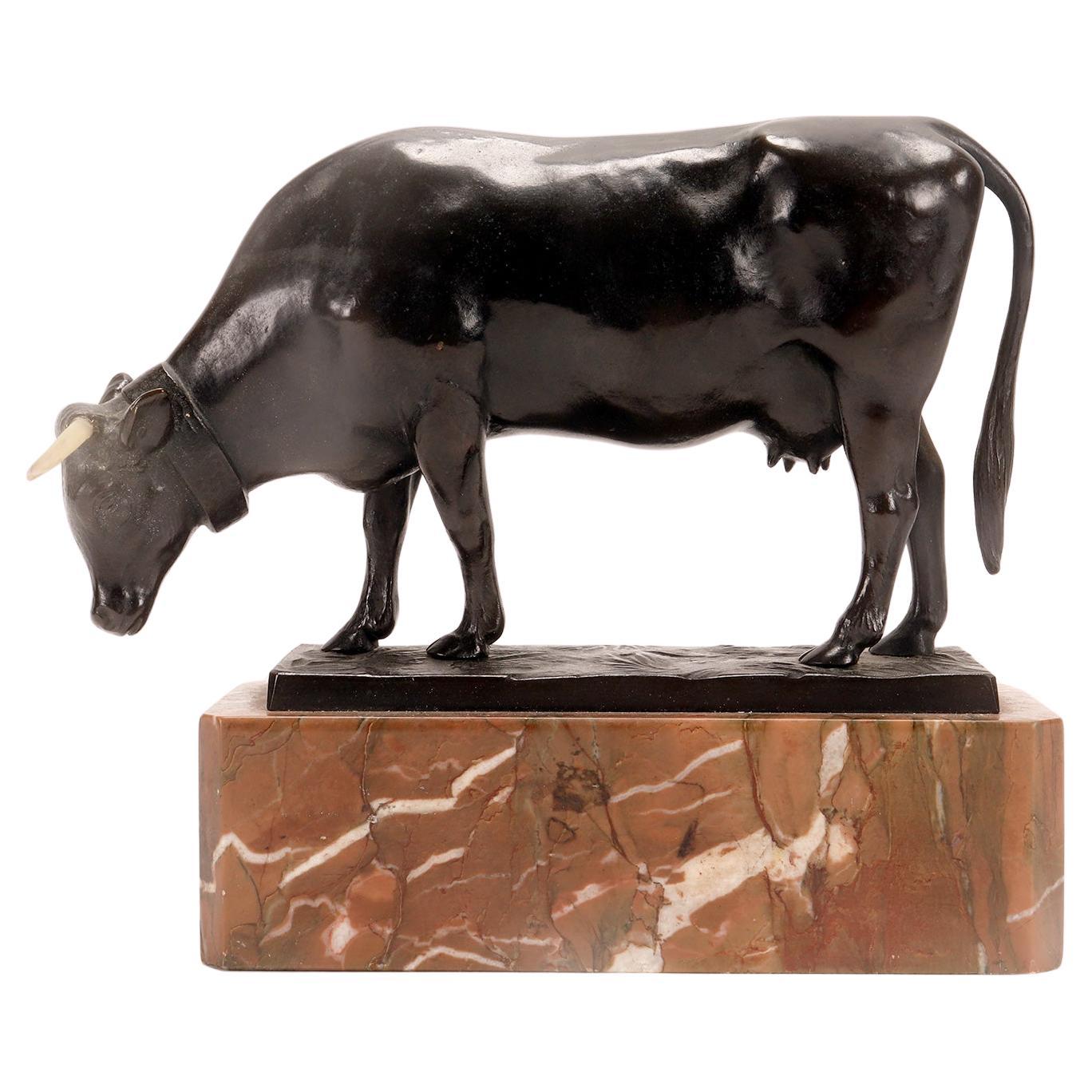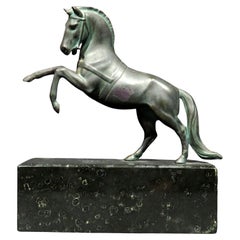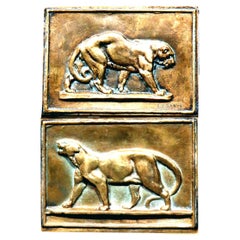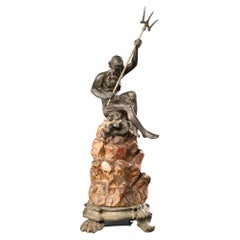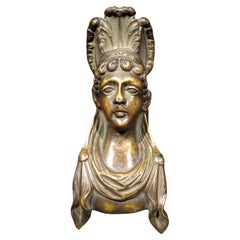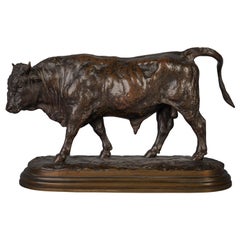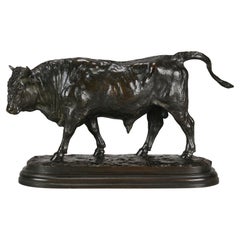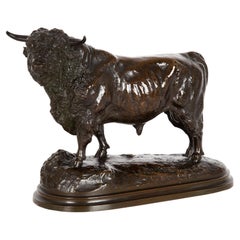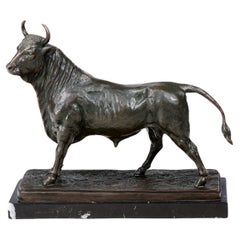Items Similar to A Fine Animalier School Bronze Figure of a Bull, After Rosa Bonheur (1822-1899)
Want more images or videos?
Request additional images or videos from the seller
1 of 11
A Fine Animalier School Bronze Figure of a Bull, After Rosa Bonheur (1822-1899)
$3,800
£2,883.35
€3,296.86
CA$5,307.57
A$5,901.30
CHF 3,081.33
MX$71,833.13
NOK 39,316.44
SEK 36,837.62
DKK 24,605.04
Shipping
Retrieving quote...The 1stDibs Promise:
Authenticity Guarantee,
Money-Back Guarantee,
24-Hour Cancellation
About the Item
Although there is seemingly no apparent foundry mark, this finely cast & patinated animalier bronze known as ‘Bull’ or ‘Taureau Beuglant’ is exemplary in demonstrating exceptional attention to musculature, proportion, definition, and superior patination. Shown standing upon a fine naturalistically modelled base, signed in the mold Rosa B.
Dimensions, 5.5” high x 8.5” wide x 3.75” deep.
In very good overall condition and priced competitively in comparison to similar examples in the marketplace. Rosa Bonheur's bronzes were cast by the Peyrol Foundry, which was owned by Rosa Bonheur’s brother-in-law, Hippolyte Peyrol. Several examples attributed to Rosa Bonheur that do not bear the Peyrol foundry mark are often deemed to be cast by the Peyrol foundry, however we cannot make that claim with any degree of certainty as regards this model.
Marie Rosalie (Rosa) Bonheur (1822-1899) was a member of the Animalier School of Sculptors, and in addition to having been a highly accomplished sculptor, she also exhibited paintings at the Paris Salon from 1841 until 1853, winning the Gold Medal twice, first in 1948 and again in 1849. Rosa Bonheur is listed in the reference guide titled 'Bronze Sculpture of “Les Animaliers” by Jane Horswell', on page #175, along with the illustration & description of this model shown on page #180. In that same reference guide it states …"she was a superb draughtsman, and the worth of her sculpture lies in its basic realism – not ‘humanised, her pictorial portrayal of the animal is absolutely as it exists in nature”.
- Similar to:Rosa Bonheur (Artist)
- Dimensions:Height: 5.5 in (13.97 cm)Width: 8.5 in (21.59 cm)Depth: 3.75 in (9.53 cm)
- Style:Beaux Arts (Of the Period)
- Materials and Techniques:
- Place of Origin:
- Period:
- Date of Manufacture:Circa 1900
- Condition:Replacements made: Later replaced screw(s) as observed on the underside of the base. Wear consistent with age and use. In extremely good overall condition, exhibiting an exceptionally fine old untouched patina. We make it policy not to disturb the surface of antique metal-ware so as to preserve the integrity of the patina that has taken decades to develop naturally.
- Seller Location:Ottawa, CA
- Reference Number:1stDibs: LU2728339567392
About the Seller
5.0
Vetted Professional Seller
Every seller passes strict standards for authenticity and reliability
Established in 1989
1stDibs seller since 2017
129 sales on 1stDibs
Typical response time: 4 hours
- ShippingRetrieving quote...Shipping from: Ottawa, Canada
- Return Policy
Authenticity Guarantee
In the unlikely event there’s an issue with an item’s authenticity, contact us within 1 year for a full refund. DetailsMoney-Back Guarantee
If your item is not as described, is damaged in transit, or does not arrive, contact us within 7 days for a full refund. Details24-Hour Cancellation
You have a 24-hour grace period in which to reconsider your purchase, with no questions asked.Vetted Professional Sellers
Our world-class sellers must adhere to strict standards for service and quality, maintaining the integrity of our listings.Price-Match Guarantee
If you find that a seller listed the same item for a lower price elsewhere, we’ll match it.Trusted Global Delivery
Our best-in-class carrier network provides specialized shipping options worldwide, including custom delivery.More From This Seller
View AllA Grand Tour Style Model of a Stallion after the Antique, Italy Circa 1900
Located in Ottawa, Ontario
A very handsome & finely modelled, patinated antimonial lead casting of a bridled stallion. Shown rearing up on it's hind legs, the head turned slightly to the right with pricked ear...
Category
Antique Early 1900s Italian Grand Tour Animal Sculptures
Materials
Marble, Other, Lead
A Rare Pair of Signed Artist Proof Animalier Bronze Plaques Attributed to Barye
By Antoine-Louis Barye
Located in Ottawa, Ontario
Both of these fine 'bas-relief' bronze plaques exhibit a fine old patina with a lustrous pinkish hue as a result of the higher ratio of copper found in this particular bronze alloy, ...
Category
Antique Late 19th Century French Beaux Arts Animal Sculptures
Materials
Bronze
A Finely Cast Spelter Figure of Neptune Mounted Atop a Carved Soapstone Base
Located in Ottawa, Ontario
The finely detailed & proportioned cast spelter figure of Neptune, dramatically poised with trident in hand, seated atop a realistically modelled hand carved...
Category
Antique Early 1900s French Neoclassical Revival Figurative Sculptures
Materials
Soapstone, Spelter
A Fine 19th Century Egyptian Revival Figural Bronze Furniture Mount, Circa 1830
Located in Ottawa, Ontario
A very attractive 19th century Egyptian Revival bronze furniture mount, cast in the form of a bust of a goddess wearing a tasseled robe, and ado...
Category
Antique Early 19th Century French Egyptian Revival Figurative Sculptures
Materials
Bronze
A Very Fine Japanese Mixed Metal Bronze Censer on Stand, Taisho Period
Located in Ottawa, Ontario
A very fine Taisho Period bronze censer of bellied oval form, richly decorated overall with hand enamelled and 'shibuichi' & 'shakudo' motifs, depicting geometric designs, pine trees...
Category
Early 20th Century Japanese Meiji Scholar's Objects
Materials
Bronze
A Very Fine Japanese Mixed Metal Bronze Suiban / Planter on Stand, Taisho Period
Located in Ottawa, Ontario
A very fine Japanese bronze Suiban (planter) of bellied oval form, richly decorated overall with hand enamelled and 'shibuichi' & 'shakudo' motifs, depicting geometric designs, pine ...
Category
Early 20th Century Japanese Meiji Scholar's Objects
Materials
Bronze
You May Also Like
French Bronze Figure of a Bull, by Rosa Bonheur
Located in New York, NY
Inscribed "Rosa B" and stamped with the "Peyrol" foundry on the base.
Category
Antique 1860s Animal Sculptures
Materials
Bronze
19th Century Animalier French Bronze Entitled "Taureau Debout" by Rosa Bonheur
By Rosa Bonheur
Located in London, GB
"Taureau Debout" by Rosa Bonheur.
An excellent late 19th Century French animalier bronze study of a standing bull with fine hand chased surface that accentuates the muscle definition of the subject, signed Rosa B.
ADDITIONAL INFORMATION
Measures: Width: 32 cm
Height: 18 cm
Depth: 11cm
Condition: Excellent Original Condition
Circa: 1870
Materials: Bronze
Book reference: Animals in Bronze by Christopher Payne
Page no. 174
DESCRIPTION
Bonheur, Rosa (1822-1899)
The most popular artist of nineteenth-century France, Rosa Bonheur was also one of the first renowned painters of animals and the first woman awarded the Grand Cross by the French Legion of Honor. A professional artist with a successful career, Bonheur lived in two consecutive committed relationships with women.
Born on March 16, 1822 in Bordeaux, Marie Rosalie Bonheur was the oldest of the four children of Raimond Oscar Bonheur (1796-1849) and Sophie Marquis. Bonheur's father was an art teacher who came from a poor family, while her mother, a musician, had descended from a middle-class family and had been her husband's art student.
Bonheur's father, who taught drawing and landscape painting, was an ardent member of the utopian Saint Simeon society.
The group held idealistic beliefs about the reform of work, property, marriage, and the role of women in society. Most importantly, for the artist's future, the Saint Simeons questioned traditional gender norms and firmly believed in the equality of women. While teaching artistic techniques to his oldest daughter, Raimond Bonheur also encouraged her independence and taught her to consider art as a career.
In 1828 Raimond Bonheur joined the Saint Simeons at their retreat outside Paris. Sophie and the children joined him in Paris the following year. Four years later, however, Raimond abandoned his family to live in isolation with his fellow Saint Simeons.
Sophie Bonheur died in 1833 at the age of thirty-six. Rosa was only eleven years old when her mother died, but she was aware of the heavy price her mother paid for married life with a man who was more dedicated to his own ideals than to meeting his family's needs. Rosa also saw that her mother's marriage led to poverty and her death from exhaustion.
After her mother's death, Bonheur was taken in by the Micas family who resided nearby. Mme Micas and Bonheur's mother had been friends. When Mme Bonheur died, the Micas family paid Raimond Bonheur's debts and cared for Rosa. Their daughther, Nathalie, who would later become an amateur inventor and unschooled veterinarian, and Rosa became enamored with each other.
When Rosa Bonheur began her career as a professional artist, she had already been trained by her father who had allowed her to study in all male classes. Rosa also learned by sketching masterworks at the Louvre from the age of fourteen, and later, by studying with Léon Cogniet.
From the very beginning, Bonheur's favorite subject was animals. She learned their anatomy completely by dissecting them in local slaughterhouses. She also visited the horse market two times a week. Study of animals by direct observation led to the formation of the realist style in which Bonheur worked.
It was for such work that Bonheur obtained written permission from the French government to wear men's slacks. Her working attire also consisted of a loose smock and heavy boots that protected her feet from the dangerous environment in which she painted. The style of dress that the artist adopted for work and home may well have been influenced by her father's attire, which was based on St. Simeonian clothing experiments. Bonheur also cropped her hair, perhaps to facilitate her work. She did, however, always wear dresses for social occasions because she knew that appropriate dress would further her career.
Bonheur earned a successful living as a painter of animals. She exhibited at the annual Paris Salon regularly from the age of nineteen in 1841 through 1853, when she was thirty-one. She won the salon's gold medal at the age of twenty-six in 1848 and was commissioned by the French government to paint Plowing on the Nivernais in 1849. In the same year Bonheur and her sister Juliette became directors of l'École gratuite de dessin pour les jeunes filles, a post their father had once held.
Bonheur completed her most renowned work, The Horse Fair, in 1855. The successful representation of percherons (a breed native to Normandy) was purchased by Ernest Gambart, a London art dealer whose gallery specialized in work by French artists. He exhibited The Horse Fair in London where Bonheur visited with Nathalie. Queen Victoria requested a private viewing of the painting at Windsor Castle. It would later be purchased in 1887 by Cornelius Vanderbilt and donated to the new Metropolitan Museum of Art in New York City.
Bonheur's trip to England allowed her to meet Charles Eastlake, then President of the Royal Academy, John Ruskin, the English writer and critic, and Edwin Landseer, the British animalier. She also toured the English and Scottish countrysides and executed some paintings based on her observations of new breeds of animals found there.
Gambart made engravings of Bonheur's work, including The Horse Fair, and sold them in England, Europe, and the United States. Bonheur became one of the most renowned painters of the time. Little girls, such as Anna Klumpke in the United States, even had dolls in her likeness, much as American girls played with Shirley Temple dolls...
Category
Antique 19th Century French Art Nouveau Animal Sculptures
Materials
Bronze
French, Antique Bronze Sculpture of Aberdeen Angus Bull by Isidore Bonheur
By Isidore Jules Bonheur
Located in Shippensburg, PA
ISIDORE JULES BONHEUR
French, 1827-1901
Taureau Aberdeen-Angus" (Standing Aberdeen-Angus Bull)
Patinated sand-cast bronze Signed to base "I. BONHEUR"
Item # 211HDB17Z
An exquisite and very rare casting of an Aberdeen-Angus bull, an unusual and distinctive breed of cattle from Scotland, this sculpture by Isidore Jules Bonheur is almost without a doubt cast by the foundry of his brother-in-law Hippolyte Peyrol and a rather early model as well in light of the distinctive construction method. In her text on the selection of 46 animal bronzes in the collection of the Georgia Museum of Art, Eleanor Luciano notes regarding this model that "Bonheur is never recorded to have been to Scotland, where he would have seen this unusual breed. Rosa Bonheur painted in Scotland, and its seems likely that Isidore would have drawn the idea for this bull either from one of her sketches or from an agricultural show in France. The animal's rich mane and strong modeling make this one of the most successful." Notable is the very fine surface patination which exhibits a glassy finish with a complex range of colors presenting in the body of the bull, overall being medium brown but augmented with an underlying reddish hue against auburn highlights. The base is signed "I. BONHEUR" in the typical manner.
Museum Collections:
* National Gallery of Art, Washington DC, acc. no. 2006.128.3
* Georgia Museum of Art, University of Georgia...
Category
Antique 19th Century French Romantic Animal Sculptures
Materials
Bronze
Late 19th Century Bronze Sculpture of Bull
By Isidore Jules Bonheur
Located in Dublin 8, IE
Late 19th Century Bronze Sculpture of a Bull by the French sculptor, Isidore Jules Bonheur. Set on a naturalistic base and raised on a black marble plinth. Signed 'I. Bonheur' and featuring a 'J.B. Deposee Bronze Garanti Paris...
Category
Antique Late 19th Century French Animal Sculptures
Materials
Marble, Bronze
Circa 1880 French Antique Bronze Sculpture “Resting Bull” by Rosa Bonheur
By Rosa Bonheur
Located in Shippensburg, PA
ROSA BONHEUR
French, 1822-1899
"Boeuf Couché" (Resting Bull)
Patinated bronze Signed "Rosa B" conceived 1846, a lifetime cast circa 1880 cold-stamped PEYROL to the reverse
Item...
Category
Antique 19th Century French Romantic Animal Sculptures
Materials
Bronze
A bronze cow sculpture signed Moseriz, France 1880.
Located in Milan, IT
A lost wax bronze sculpture depicting a cow grazing on a meadow, on a Verona red marble base. The cow's horns are made of bovine horn. Signed Moseritz. France circa 1880.
Category
Antique Early 19th Century French Animal Sculptures
Materials
Marble, Bronze
More Ways To Browse
Antique Law Office Furniture
Antique Marketplace
Patinated Bronze Bear
Bonheur Bronze
Antique Foundry Mold
Bull And Bear Sculpture
Bonheur Bronze Sculpture
Rosa Bonheur Bronze
Antique Bronze Deer
French Faience Animals
Hunting Dog Antique
Swan Feather
African Giraffe
Brass Horse Sculpture
Elephant Figurine
Marcel Cars
Metal Fish Sculptures
Miniature Glass Animals
